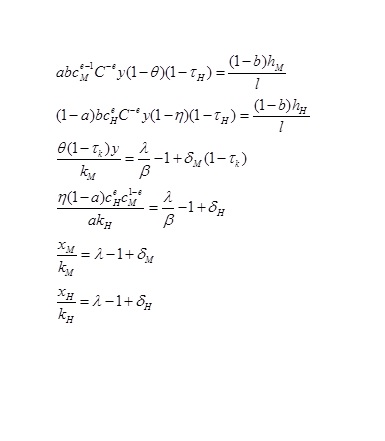Hi guys.
I need to solve RBC model with home production as stated in frontiers of business cycles.
Can you please guide me in simulating it in Dynare.
Thanks.
Hi guys.
I need to solve RBC model with home production as stated in frontiers of business cycles.
Can you please guide me in simulating it in Dynare.
Thanks.
You need to proceed as with any other model. Start with implementing the FOCs in Dynare.
Thank you so much for your guidance.
sir basically I am an engineering student, just know that for model to be solved there would be a proper closure that is number of equations should be equal to number of variables.
Upto now, I have utility function in which consumption C(t) has dependency on C_M(t) , and C_H(t) , H_M, H_H.
There are relations of C_M and C_H
Then I formulated first order conditions and get 4 equations when derivative of utlity function w.r.t C_M, C_H, H_M, H_H
How to identify exogenous and endogenous variables?

Is it not necessary to provide relation of variables. Model just include FOC only?
You need to have as many equations as variables. All FOCs and relevant definitions go into the model. Note that the constraints are a FOC as well (FOC wrt the Lagrange multiplier)
Sir when I take derivative of utility function w.r.t kmt, kht
I did not get lambda over beta in the expression instead of this I just get 1/Beta
Can you please guide me what is the problem.
The \lambda should be the Lagrange multiplier on the budget constraint. If you substitute in, you should get an expression for marginal utility.
Sir in paper basically it is stated that \lambda is growth rate. and FOC are obtained via substitution of constraint directly into utility function instead of lagrangian multiplier method.
I see. You need to transform the FOCs into intensive form after deriving them. My guess is that something like
\frac{C_{t+1}}{C_t} appears, where C_t=c_t \lambda^t so that \frac{C_{t+1}}{C_t}=\frac{c_{t+1}\lambda^{t+1}}{c_{t}\lambda^{t}}=\frac{c_{t+1}}{c_{t}}\lambda
Uppercase are aggregate variables and lowercase are intensive form.
As I am an engineering student, at first I did not get the right method to find FOC.
I was taking derivative only for instant t. But for some endogenous variables, like capital we have to expand series forward or backward to get expression for k (t+1) and k(t) or k(t-1) and k(t). Here author’s choice was k(t-1) and k(t) to solve it explicitly.
so /beta(t) and /beta(t+1) or /beta(t-1) and /beta(t) appears. I got the right direction after going through some examples.
Am i saying right? When there is endogenous variable which links it present and future value we then expand series one period in time either forward or backward. (forward for implementation of implicit numerical method and backward for explicit numerical method).
Please comment about this thing. What do you prefer?
I prefer working with a Lagrangian in an infinite sum context as this clearly shows where the variables show up. See also https://github.com/JohannesPfeifer/DSGE_mod/blob/master/RBC_baseline/Handout_RBC_model.pdf